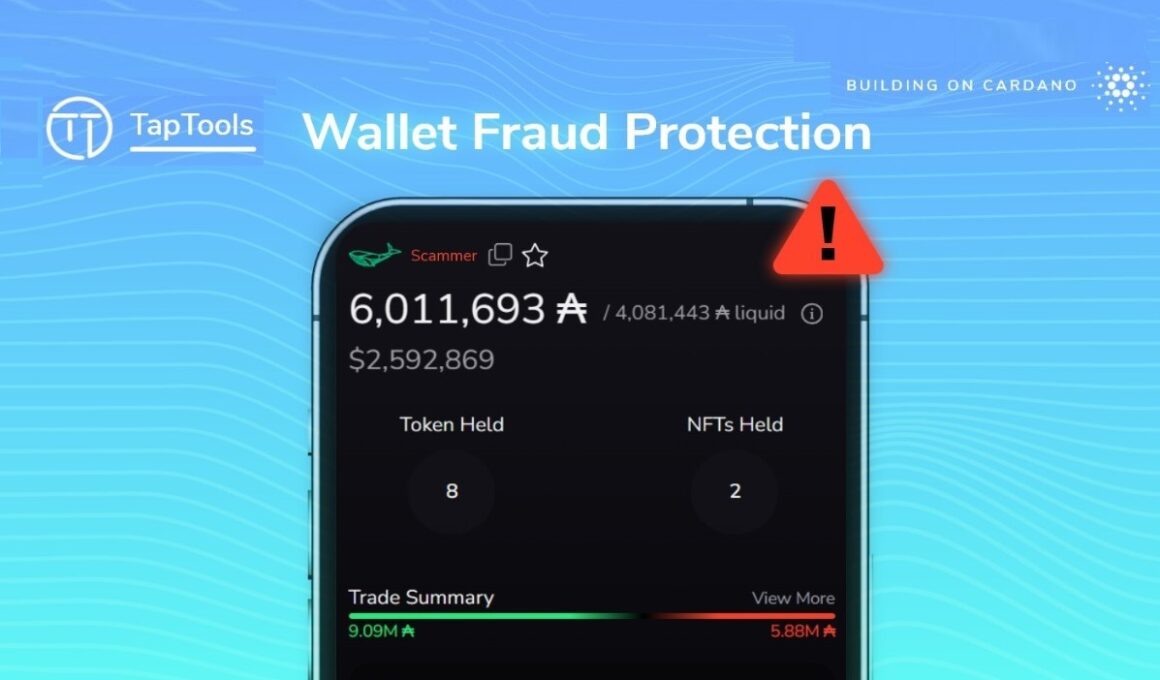Blockchain adoption is constantly growing. Year after year, more people and institutions participate in the crypto space, and that is why the industry also grows hand in hand with the flow of capital for investments in new projects.
But every rose has its thorns, malicious actors have found an opportunity in this technology, and attack crypto assets using various techniques to steal users’ funds. The modality is varied, such as the theft of private keys, the exploitation of smart contracts, and price manipulation attacks, among others.
In this graph we can see the evolution of illicit transactions in recent years:
In this graph we can see illicit transactions by crime category and asset type:
Criminals use sophisticated techniques to defraud the community, and the Cardano ecosystem is no exception, facing this scourge, for which current protection measures are not sufficient.
The TapTools team has set out to build a tool to combat criminals.
The community rates TapTools as one of the best Cardano analytics platforms, to monitor and analyze blockchain metrics, with detailed information on portfolios, trading history, asset prices, DeFi, and NFT.
The TapTools team won funding for a proposal presented at FUND9, TapTools: All-In-One Platform.
Let’s now look at the proposal for Project Catalyst FUND12.
The Proposal
The TapTools team says it has seen a consistent pattern of scammers exploiting vulnerabilities such as liquidity drains, rug pulls, and other deceptive practices.
These activities not only defraud individuals but also damage community trust and the overall reputation of the blockchain ecosystem.
Therefore, the proposal is to develop an automated algorithm to detect and report wallets that participate in fraudulent activities, such as lack of liquidity and repetitive deceptive transactions, safeguarding the ecosystem.
This solution addresses the specific issue of wallet fraud, which erodes trust and undermines the integrity of the Cardano network.
Writer’s note: Wallets are computer programs that interact with the blockchain, and most of these applications on the Cardano network are made up of multiple addresses, meaning a single address that is identified as fraudulent, qualifies in the same way other addresses that belong to that same wallet, from the same owner.
Leveraging existing data capacity TapTools, the team aims to create an advanced fraud detection system that effectively identifies and flags malicious wallets.
Writer’s Note: This tool is made possible by the traceability of the Cardano blockchain ledger. It would not be possible to develop a similar tool in privacy blockchains, such as Monero, which on the other hand would not have a greater need for this type of application, since Monero is a p2p payment system and does not develop DeFi (smart contracts) on the network, being that decentralized finances are the main objective of criminals.
The solution promises to contribute directly to Cardano’s security framework by ensuring a more secure transaction environment and protecting current users—this way new users and developers will be attracted, promoting growth and innovation within the ecosystem.
As a quantitative success metric, the number of wallets identified as participating in frauds, and liquidity pools labeled as scams, will be tracked, and thus, by seeing a reduction in fraudulent transactions over time, the effectiveness of the solution.
User feedback will be collected as a qualitative success metric, and improvements in community sentiment will serve as indicators of the impact of this tool.
The team plans to collaborate with other Cardano blockchain-based projects and platforms to integrate the fraud detection tool, thus extending its benefits to the entire ecosystem.
According to the proponents, developers on Cardano will benefit from the fraud detection API (Application Programming Interface), which they can integrate into their projects to provide additional layers of security.
Writer’s note: although this type of application is surely very useful in the proposed sense, it is important to consider that errors in the classification of the addresses that make up a wallet, reported as fraudulent, could cause serious losses of money for its owner, and This would encourage lawsuits against the development team.
The team announces that it will publish detailed reports on the system performance and the general security status of the Cardano ecosystem. These reports will be available through official social media channels, ensuring transparency and accessibility for all community members.
According to the project presentation, the fraud detection algorithm will be tested with pilot tests on historical data and a beta version for the community. This step-by-step approach will allow us to improve the system in stages, ensuring that the course is correct.
The team reports that they have decided not to make the project open source due to intellectual property protection considerations, go-to-market strategy, and security concerns.
The Milestones
Milestone 1 —Frame design
Detailed design of the fraud detection framework, including algorithm specifications and data requirements. Initial project plan with defined functions and deadlines. Approval of the design document by the project team. Acceptance of the project plan and agreement on deadlines.
Milestone 2 —Data analysis and model assembly
Completion of data collection and analysis. Initial fraud detection model developed. Data sources are integrated and operational. The initial model passes basic functionality tests.
Milestone 3 —Model refinement and beta testing
A refined model incorporating initial comments. Start of beta testing with the selected user group. The model demonstrates greater accuracy and efficiency. Get Positive feedback from beta testers on functionality and user experience.
Milestone 4 —Platform Integration
Integration of the fraud detection system into the TapTools platform. Develop user training materials and system documentation. The system integrates seamlessly with existing platform functions. The documentation meets the standards of clarity and completeness.
Milestone 5 —Full production deployment
Complete deployment of the system to all users of the platform. Establishment of supervision tools and support processes. The system works without problems with normal and maximum loads. User queries are resolved within the agreed deadlines.
Final Milestone —Project closure and evaluation
Comprehensive project report detailing results, community impact, and lessons learned. The final presentation of the project to Project Catalyst. The report effectively covers all aspects and metrics of the project.
Writer’s Note: The proposal does not specify the time to meet each milestone.
The Budget
The total funding requested for the project is 190,500 ADA, which is broken down below:
—Framework Design: 20,000 ADA
- UI/UX Design: Creation of wireframes and user interface mockups.
—Data Parsing and Model Assembly: 50,000 ADA
- Back-End Development: Development of the data parsing logic and initial model setup.
—Model Refinement and Beta Testing: 40,000 ADA
- Back-End Development: Refinement of the fraud detection algorithm.
- UI/UX Adjustments: Updates based on user feedback during beta testing.
—Platform Integration: 45,000 ADA
- Front-End Development: Fraud detection integration system into the existing TapTools platform.
- Back-End Integration: Ensuring backend compatibility and data flow integration.
—Project Close-Out and Assessment: 5,000 ADA
- Reporting and Documentation: Development of final project reports and operational documentation.
—Community Engagement and Marketing: 10,000 ADA
- Marketing Materials: Development and distribution of promotional materials.
- Community Workshops: Host AMAs to educate users on the new features.
—Project Management and Documentation: 10,500 ADA
- Project Management: Oversight and coordination of the project across all phases.
- Documentation: Creation of comprehensive user and technical documentation.
—Additional Provisions: 10,000 ADA
- Contingency Fund: Reserved for unforeseen expenses or overruns.
The Team
I will cite some of the 11 main members of TapTools below:
Alec Myers co-founder and Chief Executive Officer (CEO), Jacob Warren Chief Technology Officer (CTO), James Cadena Chief Operating Officer (COO), and Alex Yue Chief Marketing Officer (CMO).
TapTools Linktree
. . .
You can read the original proposal: TapTools: Wallet Fraud Detection










